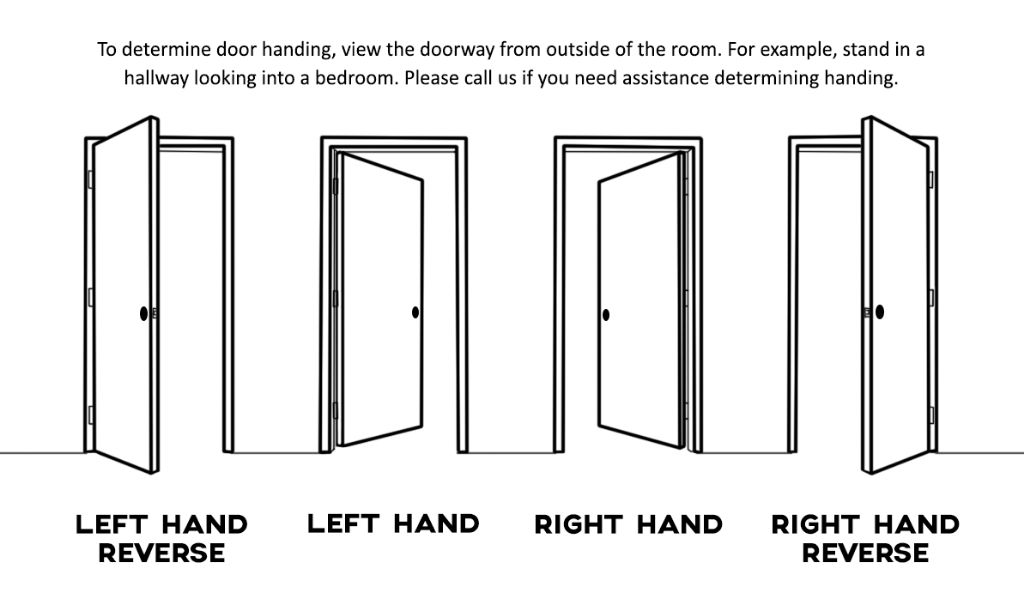Determining whether a door is left-handed or right-handed is important when installing or replacing interior and exterior doors. The hand of a door refers to the side on which the door is hinged and the direction in which the door swings when opened. Choosing the correct hand is necessary for proper clearance, accessibility, and workflow. This article will provide a step-by-step guide to identifying door hand and considerations for selecting the appropriate hand for your situation.
Page Contents
What Does Right or Left Hand Mean for Doors?
The hand of a door describes the side on which the hinges are located and the direction the door will swing when opened. A right-handed door means that the hinges are on the right side of the door frame when viewed from the outside. When opened, the door will swing to the right. Left-handed doors have hinges on the left side and open to the left.
Another way to think of it is that the side with the hinges is the “fixed” side and will remain stationary. The side without hinges is the “free” side and swings out when opened. So for a right-handed door, the right side stays fixed while the left side swings free when opened.
Why Does Door Hand Matter?
Installing a door with the wrong hand can lead to problems:
- Clearance issues – A right-handed door needs enough clearance on the left side to fully open without hitting walls or furniture. A left-handed door needs this clearance on the right.
- Difficult operation – Opening inward into a room, a wrong-handed door will tend to collide with surrounding objects.
- Safety hazards – Doors that open the wrong way can obstruct emergency exits and create dangerous situations.
- Aesthetics – Door swings should be consistent for the best visual flow in a room or space.
- Accessibility – Door hands need to allow proper access and clearance for those with disabilities.
Taking the time to correctly identify door hand will lead to optimal door function and avoid costly mistakes down the road.
How to Determine if a Door is Left or Right Handed
There are just a few simple steps to identify whether a door is left- or right-handed:
- Stand on the outside of the door facing it head-on. This is the side from which you will normally approach and enter the door.
- Identify which side the hinges are on. Hinges on the right means it’s a right-handed door. Hinges on the left indicate a left-handed door.
- Open the door and note which direction it swings. A right-handed door will open to the right, left-handed to the left.
- If you are still unsure, stand with your back to the door hinges. Raise both hands straight out to your sides parallel to the floor. Your dominant hand indicates the door’s hand.
Once you’ve established whether it’s a right- or left-handed door, double check by opening the door and ensuring clearance and operation meet your needs.
Tips for Determining Door Hand
Here are some additional tips when trying to identify the hand of a door:
- If there is no door installed yet, examine the door jamb and frame for hinge mortises or holes that indicate which side they go on.
- Sometimes you can tell if the strike plate area has been chiselled out to fit a door that opens either left or right.
- On exterior doors, hinges are typically on the interior side while the door knob and lockset are on the exterior side.
- For sliding doors, the direction of slide indicates hand. If it slides to the right it’s considered right-handed.
- Inspect the area around the door for any signs like worn carpet or flooring, scuffs, or wall damage that shows which way the door swings open.
- Ask the previous homeowners or inspect any existing documentation on the home that might specify door hand.
Considerations for Choosing Right or Left Hand
Once you’ve determined the existing door hand, you can decide if you want to keep it or change it for the new door. Here are some factors to consider:
Room Layout
Think about furniture placement and clearances. Allow enough room for the door to fully open without obstruction. Typically 36 inches of clearance is needed for interior doors.
Traffic Flow
The door hand should promote proper workflow in the space. For high traffic areas, choose the hand that supports movement patterns through the room.
Accessibility
Verify the door hand allows adequate clearance for those entering the room. The swing should not interfere with accessibility features.
Emergency Egress
Adjust hand if needed to allow unobstructed emergency exit routes from the room or building.
Door Use Frequency
For frequently accessed doors, choose the hand that makes it most convenient for the primary user.
Aesthetics
Select a uniform door hand in spaces with multiple doors for the best visual appeal.
Security
In some cases, a particular hand may make it harder for intruders to access from outside.
Building Codes
Check any applicable regulations, especially for commercial buildings. Local codes may mandate a certain door hand in some situations.
Costs
Changing the hand may require additional work and expenses for modifying framing and hardware.
Conclusion
Identifying door hand is straightforward once you know what to look for. Evaluate the existing setup as well as how the space is used to determine the optimal door hand for the situation. With some basic information and planning, you can ensure your new interior or exterior door is installed with the correct hand and functions properly for years to come.
